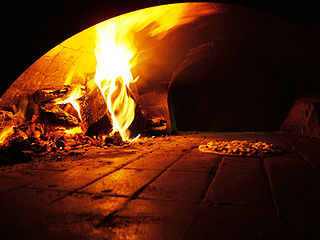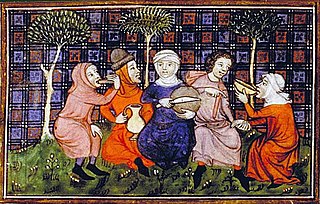
Bread is a staple food prepared from a dough of flour and water, usually by baking. Throughout recorded history and around the world, it has been an important part of many cultures' diet. It is one of the oldest human-made foods, having been of significance since the dawn of agriculture, and plays an essential role in both religious rituals and secular culture.

Baking is a method of preparing food that uses dry heat, typically in an oven, but can also be done in hot ashes, or on hot stones. The most common baked item is bread, but many other types of foods can be baked. Heat is gradually transferred "from the surface of cakes, cookies, and pieces of bread to their center, typically conducted at elevated temperatures surpassing 300°F. Dry heat cooking imparts a distinctive richness to foods through the processes of caramelization and surface browning. As heat travels through, it transforms batters and doughs into baked goods and more with a firm dry crust and a softer center. Baking can be combined with grilling to produce a hybrid barbecue variant by using both methods simultaneously, or one after the other. Baking is related to barbecuing because the concept of the masonry oven is similar to that of a smoke pit.

Cornbread is a quick bread made with cornmeal, associated with the cuisine of the Southern United States, with origins in Native American cuisine. It is an example of batter bread. Dumplings and pancakes made with finely ground cornmeal are staple foods of the Hopi people in Arizona. The Hidatsa people of the Upper Midwest call baked cornbread naktsi. Cherokee and Seneca tribes enrich the basic batter, adding chestnuts, sunflower seeds, apples, or berries, and sometimes combine it with beans or potatoes. Modern versions of cornbread are usually leavened by baking powder.

Outdoor cooking is the preparation of food in the outdoors. A significant body of techniques and specialized equipment exists for it, traditionally associated with nomad in cultures such as the Berbers of North Africa, the Arab Bedouins, the Plains Indians, pioneers in North America, and indigenous tribes in South America. These methods have been refined in modern times for use during recreational outdoor pursuits, by campers and backpackers.

An oven is a tool which is used to expose materials to a hot environment. Ovens contain a hollow chamber and provide a means of heating the chamber in a controlled way. In use since antiquity, they have been used to accomplish a wide variety of tasks requiring controlled heating. Because they are used for a variety of purposes, there are many different types of ovens. These types differ depending on their intended purpose and based upon how they generate heat.

Punjabi cuisine is a culinary style originating in the Punjab, a region in the northern part of South Asia, which is now divided in an Indian part to the east and a Pakistani part to the west. This cuisine has a rich tradition of many distinct and local ways of cooking.

An earth oven, ground oven or cooking pit is one of the simplest and most ancient cooking structures. The earliest known earth oven was discovered in Central Europe and dated to 29,000 BC. At its most basic, an earth oven is a pit in the ground used to trap heat and bake, smoke, or steam food. Earth ovens have been used in many places and cultures in the past, and the presence of such cooking pits is a key sign of human settlement often sought by archaeologists. Earth ovens remain a common tool for cooking large quantities of food where no equipment is available. They have been used in various civilizations around the world and are still commonly found in the Pacific region to date.

The following outline is provided as an overview of and topical guide to the preparation of food:

A masonry oven, colloquially known as a brick oven or stone oven, is an oven consisting of a baking chamber made of fireproof brick, concrete, stone, clay, or cob. Though traditionally wood-fired, coal-fired ovens were common in the 19th century, and modern masonry ovens are often fired with natural gas or even electricity. Modern masonry ovens are closely associated with artisan bread and pizza, but in the past they were used for any cooking task involving baking. Masonry ovens are built by masons.

Tatar cuisine is primarily the cuisine of the Volga Tatars, who live in Tatarstan, Russia, and surrounding areas.

Johnnycake, also known as journey cake, johnny bread, hoecake, shawnee cake or spider cornbread, is a cornmeal flatbread, a type of batter bread. An early American staple food, it is prepared on the Atlantic coast from Newfoundland to Jamaica. The food originates from the indigenous people of North America. It is still eaten in the Bahamas, Belize, Bermuda, Canada, Colombia, Curaçao, Dominican Republic, Jamaica, Puerto Rico, Saint Croix, Sint Maarten, Antigua, and the United States.

Medieval cuisine includes foods, eating habits, and cooking methods of various European cultures during the Middle Ages, which lasted from the 5th to the 15th century. During this period, diets and cooking changed less than they did in the early modern period that followed, when those changes helped lay the foundations for modern European cuisines.

A tabun oven, or simply tabun, is a portable clay oven, shaped like a truncated cone. While all were made with a top opening, which could be used as a small stove top, some were made with an opening at the bottom from which to stoke the fire. Built and used even before biblical times as the family, neighbourhood, or village oven, tabun ovens continue to be built and used in parts of the Middle East today.

Irish cuisine encompasses the cooking styles, traditions and recipes associated with the island of Ireland. It has developed from antiquity through centuries of social and political change and the mixing of different cultures, predominantly with those from nearby Britain and other European regions. The cuisine is founded upon the crops and animals farmed in its temperate climate and the abundance of fresh fish and seafood from the surrounding waters of the Atlantic Ocean. Chowder, for example, is popular around the coasts. Herbs and spices traditionally used in Irish cuisine include bay leaves, black pepper, caraway seeds, chives, dill, horseradish, mustard seeds, parsley, ramsons, rosemary, sage and thyme.

Podpłomyk, known in Old Polish as wychopień or wychopieniek, is the oldest known Slavic form of bread, in the form of a small flatbread baked on an open fire. It has been preserved to the modern day as a part of Polish cuisine.

Nordic bread culture has existed in Denmark, Finland, Norway, and Sweden from prehistoric times through to the present. It is often characterized by the usage of rye flour, barley flour, a mixture of nuts, seeds, and herbs, and varying densities depending on the region. Often, bread is served as an accompaniment to various recipes and meals. Nordic breads are often seasoned with an assortment of different spices and additives, such as caraway seeds, orange zest, anise, and honey.

Tandoor bread refers to a bread baked in a clay oven called a tandoor.

Ancient Israelite cuisine refers to the culinary practices of the Israelites from the Late Bronze Age arrival of Israelites in the Land of Israel through to the mass expulsion of Jews from Roman Judea in the 2nd century CE. Dietary staples among the Israelites were bread, wine, and olive oil; also included were legumes, fruits and vegetables, dairy products, fish, and meat.
Hazara cuisine or Hazaragi cuisine refers to the food and cuisine of the Hazara people in Afghanistan and western Pakistan. The food of the Hazara people is strongly influenced by Central Asian, South Asian cuisines and shares similarities with neighboring regional cuisines in Afghanistan and Central Asia. However, there are certain dishes, culinary methods and styles of cooking that are unique to the Hazara people.

















